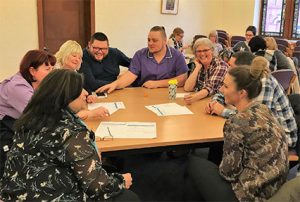conference report
Getting creative in commissioning
Commissioners are determined to come up with novel solutions to ensure good practice
despite an uncertain future for social care. Rose Trustam reports on the commissioners’
conference, where service integration and new models of service provision were discussed
Unsustainable Pressure? The Future of Health and Social Care – National Commissioning and Contracting Training Conference, 2018
Amid a tough climate, this conference, run by and for commissioners, showed a determination to share, challenge and find solutions, as well as showcasing good practice.
Neither the government nor the opposition is providing the political strategic thinking social care needs, said ADASS president Glen Garrod, when he opened the event. Garrod, who is executive director of adult care and community wellbeing at Lincolnshire County Council, said the future of social care looked unsustainable, unstable and uncertain across the country.
In his ADASS role, he has previously said: “Pouring money into the NHS without investing in social care is like pouring water down a sink with no plug in.”
The conference was chaired by Mike Webster, retired assistant director of health and adult services at North Yorkshire County CounciI. The opening keynote speeches majored on health and social care integration, with a green paper due.
Garrod felt integration should cover housing, while Jon Rouse, chief officer at Greater Manchester Health and Social Care Partnership, said Manchester had asked for welfare benefits to be included.
Jacquie White, director of the National System Transformation Group at NHS England, identified three levels of integration, with budgets able to move between them. These are:
- Neighbourhood level: this is where integration starts, and would involve strengthening community, preventive and post-hospital services, with neighbourhood-based budgets
- Place-based level: different services with common issues would be brought together, and staff shared
- System-level: this final level would employ joined-up digital strategies.
Garrod was concerned to maintain councilsÕ strong, direct local links and accountability, echoing the need to start with neighbourhoods. He commended the Local Government Association (2018) for having reached political consensus in its own green paper on social care.
With oversight of the development of the 42 sustainability and transformation partnerships, White explained how these would move towards integrated care systems, driven from the ground up by ‘getting under what’s really going on locally’. The next stage would be ‘shadow’ integrated care systems, involving the development of relationships where people give up things for the greater good, and move to partnership beyond health to wider public services.
Garrod shared some areas for optimism. These included personal budgets. He cited Warrington’s personal health budget pilot on end-of-life care which had enabled 83 of 100 people to die at home as they had wished (NHS England, 2018).
He also discussed homes with built-in design standards for later life, technology to improve independence and for self-help (including for online shopping), integrated practice, pooled budgets and joint commissioning. Self-assessment could be made simpler, he said; for example, Leeds City Council has a two-page form to complete, while Lincolnshire County Council’s runs to 24 pages.
Resilience is built through having the right people, communications and professionals, and people should share resources and collaborate, he said. An integrated experience should be possible, he noted, inviting delegates to consider how Amazon manages to give people an invisible integrated service.
Contracting differently
Tameside Metropolitan Borough Council and local providers have changed how they contract home care services.
Tameside worked with current and potential providers to design the new model and tender; it then contracted providers to cover six zones on a six-year contract. The work was funded by the Greater Manchester Transformation fund.
The provider uses the social worker’s assessment and personal budget to produce a care plan with the client. They both consider help from family and friends, assistive technology and anything that would help them to better connect with the community, as well as what is needed from Tameside Support at Home Service.
Around half of the 9,500 weekly hours for 950 people have been provided. There is a key worker system, which motivates staff so improves recruitment and retention, and providers maintain contact if people go into hospital. There are monthly provider meetings and pilots of low-level health tasks, digital health and electronic monitoring.
While funding is tight, more people are being helped within the same amount of time, and providers are integrating more with local services.
Conference presentations can be downloaded from www.ncctc.co.uk/presentations/navigate/443/306
The presentation on A new model of home care – a person-centred approach can be downloaded from www.ncctc.co.uk/download_file/267/194
ADASS (2018) adass responds to public accounts committee report on social care and health integration. 2018. http://tinyurl.com/ybphxgou
Local Government Association (2018) The lives we want to lead. http://tinyurl.com/yakey8qs
NHS England (2018) Warrington. http://tinyurl.com/y962mhy2

